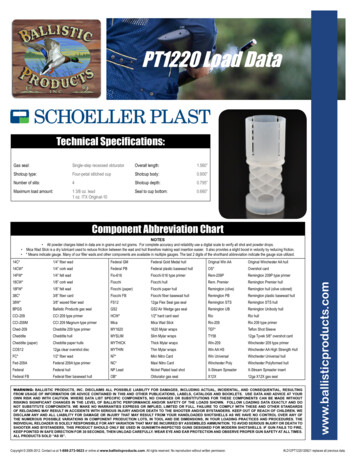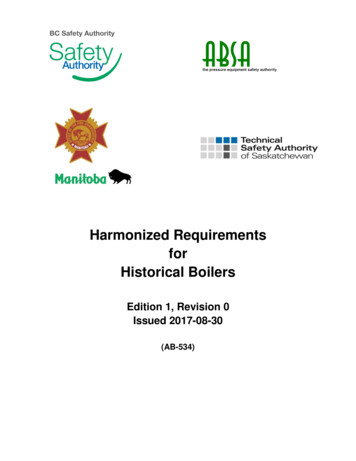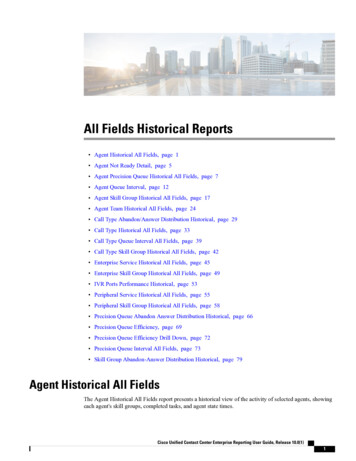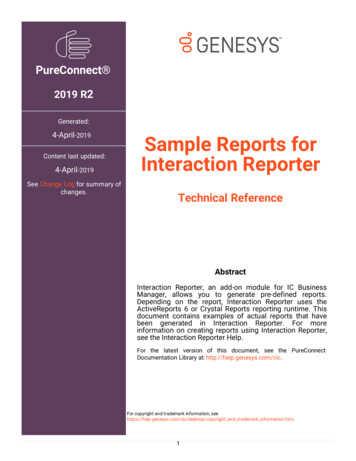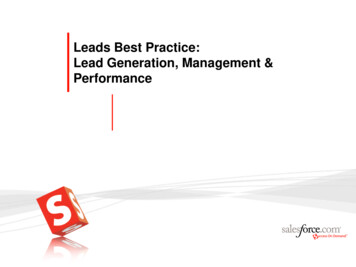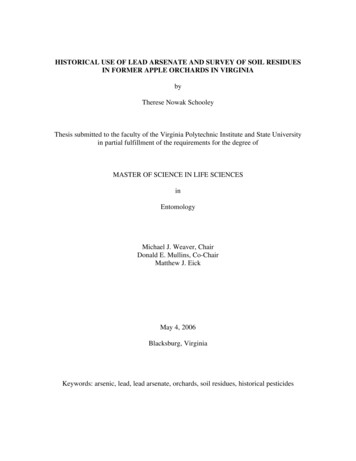
Transcription
HISTORICAL USE OF LEAD ARSENATE AND SURVEY OF SOIL RESIDUESIN FORMER APPLE ORCHARDS IN VIRGINIAbyTherese Nowak SchooleyThesis submitted to the faculty of the Virginia Polytechnic Institute and State Universityin partial fulfillment of the requirements for the degree ofMASTER OF SCIENCE IN LIFE SCIENCESinEntomologyMichael J. Weaver, ChairDonald E. Mullins, Co-ChairMatthew J. EickMay 4, 2006Blacksburg, VirginiaKeywords: arsenic, lead, lead arsenate, orchards, soil residues, historical pesticides
HISTORICAL USE OF LEAD ARSENATE AND SURVEY OF SOIL RESIDUES INFORMER APPLE ORCHARDS IN VIRGINIATherese Nowak SchooleyAbstractInorganic pesticides including natural chemicals such as arsenic, copper, lead, and sulfurhave been used extensively to control pests in agriculture. Lead arsenate (PbHAsO4) wasfirst used in apple orchards in the late 1890’s to combat the codling moth, Cydiapomonella (Linnaeus). The affordable and persistent pesticide was applied in everincreasing amounts for the next half century. The persistence in the environment inaddition to the heavy applications during the early 1900’s may have led to many of thecurrent and former orchards in this country being contaminated. In this study, soilsamples were taken from several apple orchards across the state, ranging from Southwestto Northern Virginia and were analyzed for arsenic and lead. Based on naturallyoccurring background levels and standards set by other states, two orchards sampled inthis study were found to have very high levels of arsenic and lead in the soil, Snead Farmand Mint Spring Recreational Park. Average arsenic levels at Mint Spring RecreationalPark and Snead Farm were found to be 65.2 ppm and 107.6 ppm, respectively. Averagelead levels were found to be 354.5 ppm and 442.3 ppm, respectively. Based on theseresults, Virginia needs to look at setting standards for lead and arsenic in soil todetermine if cleanup of former agricultural lands will be necessary.
ACKNOWLEDGMENTSI would like to acknowledge the following people for their individual contributions madeduring my graduate work:These individuals were responsible for helping me gain access to sampling sites locatedin the George Washington and Jefferson National Forest.Charlie Conner – Retired Extension AgentEd Leonard – Forrester, George Washington and Jefferson National Forest RangerStation (NRV district)Dewey Snavely – farmerJohn Pound – Virginia Game and Inland Fisheries Department in Bath County. Johnpersonally drove me around to many potential sampling sites. Access to many of theseorchards would have been impossible without his assistance.David Carr – Curator and Acting Director of the State Arboretum of Virginia. Davidgave permission to sample on site and also gave access to several priceless historicphotographs of Blandy Experimental Farm.Glen Hetzel – farmer and retired Extension Specialist. Allowed me access to hisfamily’s farm.Walter Smith – Author, “The Last Orchard in Shenandoah National Park”. Mr. Smithsent me valuable information regarding the Snead Farm from his book (publicationpending).The following people were critical in granting me a research permit in the ShenandoahNational Park.Reed Engle – Cultural Resource Specialist, Shenandoah National ParkSharon Henry – Natural Resources, Shenandoah National ParkShane Spitzer – Physical Scientist, Shenandoah National ParkThe following people were responsible for bringing the Mint Spring Park site to ourattention and were crucial with supplying information about previous water sampling andthe history of the park.Doug Pfeiffer – Professor, Virginia Tech Department of EntomologyDavid Wayland – Owner of Wayland Orchard, Crozet, VAStephen Bowler – Watershed Manager, Albemarle CountyDavid Hirschman – Water Resources Manager, Albemarle CountyPat Mullaney – Director, Albemarle County Department of Parks and RecreationMatt Smith – Park Superintendent, Albemarle County Parks and RecreationDiane Linkous – Office Manager, Virginia Tech Pesticide ProgramsSandra Gabbert – Lab Supervisor, Virginia Tech Department of Entomologyiii
A special thanks to my thesis committee members who have been extremely patient withmy progress. Without their guidance, knowledge and persistence I would have been lost.Matt Eick – Associate Professor, Department of Crop & Soil Environmental ScienceDon Mullins – Professor, Virginia Tech Department of EntomologyMike Weaver – Professor, Virginia Tech Department of EntomologyAnd finally, thanks to my husband, Chris, for all his support and who braved the snakesand poison ivy with me on more than one occasion.iv
TABLE OF CONTENTSABSTRACT.iiACKNOWLEDGEMENTS .iiiTABLE OF CONTENTS . vLIST OF FIGURES . viLIST OF TABLES . viiIntroduction. 1Literature Review. 5Lead arsenate. 6Soil residues . 11Health risks. 12The scope of the problem in Virginia. 16Soil contamination in other States. 20Remediation . 29Standards for arsenic and lead in the environment. 31Farming techniques. 31Methods and Materials . 38Sampling . 38Lab Techniques . 39Results and Discussion. 42Collection of samples and locations . 44Soil Analysis . 46Glen Alton Farm. 46Smyth/Wythe County Apple Orchard . 48Blandy Experimental Farm . 50Snead Farm . 53Hetzel Farm. 57Folly Farms & June Cleek Farm. 59Mint Spring Recreational Park . 61Summary and Conclusion. 65Practical solutions and recommendations for landowners. 67Further research needed in Virginia . 68References . 70v
LIST OF FIGURESFig. 1. Orchard workers harvesting apples with horses and wagons . 2Fig. 2. Subdivisions in Virginia. 3Fig. 3. Apple trees being sprayed with lead arsenate at Blandy Experimental Farm . 7Fig. 4. A former pesticide-mixing site and shed in Mint Spring Recreational Park. 7Fig. 5. Diagram showing the process of making lead arsenate . 8Fig. 6. Apples going through a final fresh water rinse through spray nozzles . 10Fig. 7. Cancerous lesion on hand and nodular hyperkeratosis on feet. 14Fig. 8. Panoramic view of a commercial apple orchard in bloom. 16Fig. 9. Map showing distribution of commercial apple orchards in Virginia . 17Fig. 10. A commercial peach orchard in Frederick County, VA. 18Fig. 11. Map showing distribution of commercial peach orchards in Virginia. 19Fig. 12. A bulldozer removes soil from a yard at Barber Orchard . 22Fig. 13. Brake fern, Pteris vittata, is sold by Edenspace as the edenfern . 30Fig. 14. Powdered lead arsenate displayed in two different types of packaging. 34Fig. 15. Six-hole whirl discs. 35Fig. 16. Apple trees sprayed with a hand-held boom . 36Fig. 17. Rusty pipes pulled from the orchard and piled together at Snead Farm . 37Fig. 18. Mixing/loading site at Hetzel Farm and mixing site at Mint Spring Park . 39Fig. 19. Distribution of orchard soil sampling sites across the Commonwealth . 45Fig. 20. Glen Alton Farm apple orchard in Giles County, VA . 46Fig. 21. Glen Alton Farm – USGS aerial photograph. 47Fig. 22. Smyth/Wythe County, VA Apple Orchard. 49Fig. 23. Blandy Experimental Farm apple orchard and apple packing shed. 50Fig. 24. Blandy Experimental Farm orchard 2001 . 51Fig. 25. Blandy Experimental Farm – USGS aerial photograph . 52Fig. 26. Snead Farm stone house foundation and barn (Shenandoah National Park). 54Fig. 27. Snead Farm apple orchard overgrown in Shenandoah National Park. 54Fig. 28. Snead Farm in Shenandoah National Park – 1937 aerial photograph. 55Fig. 29. Broken apple tree (left) and split apple tree (right) at Snead Farm . 57Fig. 30. Hetzel Farm apple orchard (#2) in Berryville, VA – 2001. 58Fig. 31. Former apple orchard site at June Cleek Farm– 2001. 60Fig. 32. John Pound of the VDGIF taking a soil sample on Folly Farms in 2001 . 60Fig. 33. Apple tree overgrown with grapevine in Mint Spring Park in 2002. 62Fig. 34. Mint Spring Park – USGS aerial photo. 63vi
LIST OF TABLESTable 1. An estimated total amount of lead arsenate (tons) applied over a 20-year periodin Virginia’s commercial apple orchards . 17Table 2. Arsenic and Lead Soil Concentrations and Cleanup Levels at Barber Orchard21Table 3. General spray recommendations for apples . 33Table 4. Summary of soil sampling sites in the Commonwealth of Virginia. 43Table 5. Total lead and arsenic residues (ppm) found in soils sampled at Glen AltonFarm . 48Table 6. Total lead and arsenic residues (ppm) found in soils sampled at Smyth/WytheCounty Apple Orchard . 50Table 7a. Total lead and arsenic residues (ppm) found in soils sampled at BlandyExperimental Farm – Orchard #1 . 52Table 7b. Total lead and arsenic residues (ppm) found in soils sampled at BlandyExperimental Farm – Orchard #2 . 53Table 8a. Total lead and arsenic residues (ppm) found in soils sampled at Snead Farm –Main orchard behind house . 56Table 8b. Total lead and arsenic residues (ppm) found in soils sampled at Snead FarmApple packing shed. 56Table 8c. Total lead and arsenic residues (ppm) found in soils sampled at Snead Farm –Old well and pile of pipes . 56Table 8d. Total lead and arsenic residues (ppm) found in soils sampled at Snead Farm –apple trees left on farm. 56Table 9a. Total lead and arsenic residues (ppm) found in soils sampled at Hetzel Farm –Orchard #1. 58Table 9b. Total lead and arsenic residues (ppm) found in soils sampled at Hetzel Farm –Orchard #2. 59Table 10. Total lead and arsenic residues (ppm) found in soils sampled at June CleekFarm . 61Table 11. Total lead and arsenic residues (ppm) found in soils sampled at Folly Farms. 61Table 12a. Total lead and arsenic residues (ppm) found in soils sampled at Mint SpringPark – Mountain trail samples #1 . 64Table 12b. Total lead and arsenic residues (ppm) found in soils sampled at Mint SpringPark – Lake samples #2 . 64Table 12c. Total lead and arsenic residues (ppm) found in soils sampled at Mint SpringPark – Lake trail samples #3 . 64Table 13. Summary of soil surveys for Blandy Experimental Farms, Mint SpringRecreational Park, and Snead Farm. 66Table 14. Summary of results from soil sampling sites in the Commonwealth of Virginia. 66vii
IntroductionIn the late 1800’s inorganic pesticides were used extensively to control pests inagriculture. These natural chemicals, including arsenic, copper, lead, and sulfur, weremixed into varying formulations and were quite effective in controlling the damagecaused by pests to meet the increasing standard of quality imposed by the consumer.Newly emerging pests and multiplying labor costs led to an increased use of pesticides bygrowers.Lead arsenate (PbHAsO4) was first used in apple orchards in the 1890’s to combat thecodling moth, Cydia pomonella (Linnaeus), a destructive insect of apples. This inorganicpesticide was very popular among farmers due to its immediate effectiveness. It was alsoinexpensive, easy to mix and very persistent. Over the next six decades, lead arsenatewas sprayed in ever increasing amounts to control apple pests in multiple applications perseason. This increase in use eventually resulted in pesticide resistance, which decreasedits efficacy and required growers to increase rates and applications (Frear and Worthley,1935) to compensate for a loss in efficacy. This loss in efficacy resulted in growerseventually switching to more viable alternate methods of treatment, such as DDT. Thecharacteristics of the compounds that created this persistence, namely the basic nature ofthe elements in the pesticide, and the increase in use and rates are the key factorscontributing to the contamination of thousands of acres of land across Virginia and theUnited States.Apple production in the late 19th and early 20th century was very widespread. This highproduction reflected a localized agricultural market and lower production of fruit peracre. This was a drastic difference to today’s world market and higher production, whichhas reduced acreages in Virginia alone to less than 18,650 acres (bearing and nonbearing) (Tuckey et al., 2000) [15,000 acres in 2002 – based on Virginia AgriculturalStatistics Service (VASS) data]. Today, the total number of commercial apple growersin Virginia (2005) is about 250 (15,000 nationally). Yields of apples in Virginia wereoften measured in bushels. In 1914, there were 15 million bushels of apples harvested inVirginia (Fig. 1), and that was the high for the years 1906-1925 (Mattice, 1927). There1
were 300 million pounds of apples harvested in Virginia in 2004 [(7,143,000 bushels @42 lb/bushel), Virginia Agricultural Statistical Bulletin, 2005].Fig. 1. Orchard workers harvesting apples with horses and wagons. – Virginia Tech Digital Archives,Newman Library (date unknown).As an increasing post World War II population began migrating out of urban areas intothe American rural landscape, farmland was developed into subdivisions. Economictrends caused dramatic changes in agricultural practices. Foreign trade globalizedfarming and shut down many small farms. Farms could not compete with moderntechnical and manufacturing jobs that paid higher wages in rural areas. Farms were soldoff as land values increased in parallel with the decreasing ability of common farmers tomaintain a profitable enterprise. Today, housing developments occupy the land whereproductive apple orchards of seventy-five years ago once stood (Fig 2). This continues tobe an ongoing problem that affects modern landuse in our communities.2
Fig. 2. Subdivisions in Staunton, VA (left) and in Waynesboro, VA (right) built in former apple orchards.As more homeowners become aware of historical pesticide use and it’s persistence in theenvironment, the questions that arise are these:1. What are the potential risks for families living on these former agriculture lands?2. What are the potential risks for domestic animals, livestock, or wildlife?3. Is lead arsenate, once used as a pesticide, found in the soil at high enough levels towarrant concern?4. Can these chemicals move off-site and pose a hazard elsewhere?5. How do people who live on these lands deal with the issue?Throughout the country many states have recognized this potential problem and have setstate-specific standards for arsenic and lead residues, in soil and in drinking water. TheEnvironmental Protection Agency (EPA) has also set national standards for arsenic andlead in drinking water and for lead in bare soil. However, Virginia has yet to setstandards for these elements in soil leaving property owners with many questionsregarding the future use of their land.This thesis will examine the scope of the issue in the Commonwealth of Virginia.Samples were taken from across the state to determine the levels of lead arsenate stillpresent in the soil. Secondly, this thesis will develop conclusions regarding the3
seriousness of the risk posed by the level of lead arsenate still present in the soil of ourcommunities by comparing lead and arsenic levels found in Virginia apple orchard soilsto standards set by other states and the EPA.For this study, soil samples were taken from many apple orchards across the state,ranging from Southwest Virginia to Northern Virginia. However, due to real estatedisclosure laws almost all of the samples analyzed for lead and arsenic for this study weretaken from former commercial orchard sites now located on public land. BecauseVirginia has no set soil standards for arsenic and lead, results from this study werecompared to standards set by other states and the EPA to determine the potentialcontamination levels in Virginia.The first step of this process was to examine previous research completed on this subjectand its relevance to this study.4
Literature ReviewDuring the Industrial Revolution, the nation’s population grew and families migratedfrom rural settings to cities to secure steady employment. This population shift caused agreater demand for produce and goods, increasing production of these products. Thestandards for produce also increased with variety. Production of foodstuffs in the U.S.was forever altered. Many small sustenance farms suddenly grew into large commercialproducers. Apple production, for example, grew from small acre plots to orchards oftenhundreds of acres in size. With this increased acreage came an exponential jump in pestpopulations. Growers were suddenly faced with challenges of newly emerging pests andincreasing labor costs for control of those pests. These factors together led to anincreased use of pesticides.Inorganic pesticides, such as arsenic, copper, lead, and sulfur, have been mixed intovarious formulations for hundreds of years and were quite effective in controllingdiseases and pests. These chemicals, most popular for use in agriculture from the mid1800s to the mid-1900s, tend to be stable in the environment and are soluble in water.Sulfur, one of the oldest pesticides, is quite effective in controlling mites of all speciesand is quite useful as a fungicide against powdery mildew. Bordeaux mixture was acombination of copper and lime and was accidentally discovered in 1885 as a fungicidewhen a French farmer applied it to his grapes to keep children from eating them. Copperarsenate (copper acetoarsenite), famously known as Paris green, was green because of itscopper content and was the first commonly used arsenical according to Ware andWhitacre (2004). It was an effective insecticide in the 1860’s against the Colorado potatobeetle, Leptinotarsa decemlineata (Say), and the codling moth, C. pomonella, in the1870’s. London purple, a mixture of arsenic, lime, and acids, was another successfulinsecticide and was also used to control Colorado potato beetle in the late 1800’s.Calcium arsenate was a heavily used arsenical in the early- to mid-1900’s. Used mainlyin the south and southeast United States to control grasshoppers and the boll weevil,Anthonomus grandis grandis (Boheman), in cotton, it was also used as a generalinsecticide on a variety of vegetable crops (Murphy and Aucott, 1998).5
Arsenicals are considered stomach poisons. They only exert their toxic effects onceingested by insect pests and have a very complex mode of action. First, they uncoupleoxidative phosphorylation by substitution of the arsenate ion for phosphorous, which isan important energy-producing step of cells. Next, the arsenate ion inhibits certainenzymes that contain sulfhydryl groups. And finally, both the arsenite and arsenate ionscoagulate protein by causing the shape or configuration of proteins to change (Ware andWhitacre, 2004). Of course, the most heavily used arsenical throughout the country andworldwide was lead arsenate.Lead arsenateLead arsenate, PbHAsO4, was first used in 1892 as an insecticidal spray against the gypsymoth, Lymantria dispar (Linnaeus), in Massachusetts. It replaced Paris green because ofthe phytotoxic effects Paris green had on the foliage of trees when used at a high rates.When lead arsenate was used as a foliar spray (Fig. 3), it adhered to the surface of theplant well, allowing the pesticidal effects to last a long time (Peryea, 1998). Due to thispersistence, lead arsenate quickly became one of the most commonly used insecticides infruit tree orchards and one of the earliest insecticides used against major pests, like thecodling moth. The codling moth, C. pomonella, is a very destructive insect to apples.Damage occurs to the fruit when the larvae tunnel into the sides and calyx end of theapple all the way to the core. This damage greatly lowers the storage quality and marketvalue of the fruit leading to a loss in yield (Hull et al., 2002). According to the AmericanPomological Society (1976), without treatment the codling moth would regularly damage20% -95% of the apples in every orchard.6
Fig. 3. Apple trees being sprayed with lead arsenate at Blandy Experimental Farms (Boyce, VA) – 1920s –Blandy Farm Archives.Initially, farmers on site mixed lead arsenate (Fig. 4) by reacting soluble lead salts withsodium arsenate, however lead arsenate was also sold commercially as powders andpastes.Fig. 4. A former pesticide-mixing site and shed in Mint Spring Recreational Park (Crozet, VA) – 2002.The formulations became more refined over time and eventually two principal formsemerged; basic lead arsenate, Pb5OH(AsO4), (Fig. 5) was used in certain areas in7
California and acid lead arsenate, PbHAsO4, was used in all other locations (Peryea,1998).WHITE ARSENICNITRIC-ACIDWATERARSENIC-ACIDACETIC ACIDLITHARGE*AGITATORCOLORINGLead Arsenate SlurrySTEAMLABORATORY TESTSFILTERINGDRYINGMILLINGPACKAGINGFig. 5. Diagram showing the process of making lead arsenate. This diagram was redrawn from thetextbook “Spray Chemicals and Application Equipment” by McClintock and Fisher originally published in1945. *Litharge is a yellow lead oxide, PbO, also called lead monoxide.Virginia, at one point, played an important role in mining arsenic and lead and was aleading source for the mid-Atlantic region of the United States. Briton Arsenic Mine islocated in Floyd County, in Southwest Virginia and began mining in 1903 until it closedthe operation after World War I in 1919 (Chaffin, 2003). According to Chaffin (2003),this operation also converted the arsenopyrite (FeAsS) to white arsenic (As2O3) on siteand then shipped to various pesticide manufacturers. Lead was mined in Wythe County,Virginia and had a deep history during the Revolutionary and Civil Wars until it closed inthe early 1980s.Due to the great success of controlling the codling moth in apples, lead arsenate becamethe primary insecticide used in apple orchards. According to Marlatt (1904), in theUnited States Department of Agriculture (USDA) Agriculture Statistics yearbook, it wasstated, “essentially all commercial apple orchards were treated with arsenic”. Several8
sprays of lead arsenate, at a rate of two to four pounds per 100 gallons of water, wereapplied to the apples during a season. This generally occurred one to three times a seasonand gradually increased to five to six times a season. According to Murphy and Aucott(1998) the USDA’s Agricultural Statistics yearbooks state that in 1929 the U.S.consumption rate of lead arsenate was 29.1 million pounds, peaking in 1944 with anestimated 86.4 million pounds and then declining to only 3.9 million pounds by 1973.From the peak usage in the 1940’s until the 1970’s, lead arsenate use declined becausemore effective pesticides became available, however, it was still used extensively and theapplication rates and amounts continued to increase. The exorbitant amount isdocumented in the 1966 Agriculture handbook (USDA, 1966), which suggested that tocontrol codling moth in apples a grower should use three pounds of active ingredient per100 gallons or 30 pounds of active ingredient per acre. By the end of the 1930’s otherpests became major problems for crops that were no longer susceptible to these highdoses of lead arsenate. A search began for alternatives to lead arsenate, however, thesubstitutes were found to be less effective in insect control or were more toxic to plantsand animals.With the heavy use of lead arsenate well documented, researchers across the countrybegan to look at the spray residues on the fruit. According to Shepard (1939), it wasdiscovered that in 1919, common washing practices were failing to adequately removearsenic residues from produce. A study conducted by the Virginia AgriculturalExperiment Station (Hough et al., 1931) concluded that three sprays of lead arsenateapplied in May and June did not require removal of spray residue at the time of harvest.However, when a third or fourth spray of lead arsenate was applied in the month of Julyfollowed by dry weather, excessive residues remained on the apples at harvest.According to Hough et al. (1931), wiping or brushing the apples only removedapproximately one-third of the total arsenical residues while washing fruit in a dilutedhydrochloric acid solution consistently removed excessive residues (approximately 70percent) (see final rinse in Fig. 6). According to Frear and Worthley (1935), the smallerapples from the lower limbs of the trees usually carried the greatest amount of sprayresidue and were collected for their study. A hydrochloric acid bath (various strengths)9
in a flotation washer was successful in removing only 70 percent of lead and 75 percentof arsenic residues from the apples. Adding wetting or foaming agents to the bath did notshow any significant removal of residues. However, increasing the temperature of thebath increased the removal to approximately 80 percent of lead and 85 percent of arsenic.The variety of apples also played an important factor in the ease of the residue removal.When lead arsenate was later used in an oil-spray program, it was necessary to removethe spra
Walter Smith – Author, “The Last Orchard in Shenandoah National Park”. Mr. Smith sent me valuable information regarding the Snead Farm from his book (publication pending). The following people were critical in granting me a research permit in the Shenandoah National Park. Reed Engle – Cultural Resou


